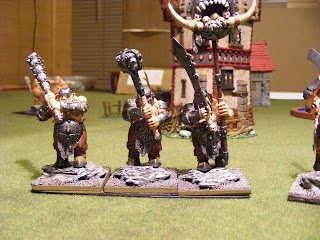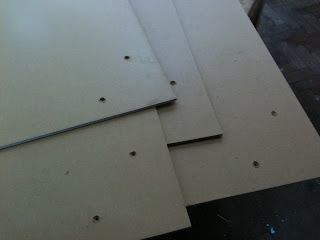The first character I decided to make was that of a slaughter-master/butcher. The ogre race is inflicted with an insatiable appetite and the ogre magicians are the most glutinous of the race! They differ from the regular ogres in that they don't where a gut plate. This presented a problem as the basic figure has a huge hole in the middle to accommodate the plate. I over came this with green stuff filling the hole and forming a huge belly. To balance this I also increased the back fat with green stuff as well.
The wizard staff is a modded flag pole with a skaven claw-rock fixed to the end.
One of the extras that you get on the ogre sprue is the hock on ropes. To indicate a 'take out meal' I attached a couple of meat joints , also from various ogre sprues.
I would like to try out a unit of Man Eaters in the army but for a unit of 4 your looking at around £80, ouch! Again out came the green stuff to create simple mods to distinguish the models from regular ogres. I wanted a pirate theme so pirate hats all round! When I paint I intend to have a skull and crossbones symbol on the banner.
Each Maneater I have given a pistol. This is for ranged attacks and the extra attack in combat. The ogre sized pistols are from the mournfang kit.
I gave the bellower a telescope from the manor house kit to give him a nautical themed weapon.
When you're out of ammo use your pistol as a club - truly the ogre way!
The Thundertusk/stonehorn kit comes with many of the components required to make a hunter. I didn't use the bits as I built the thundertusk.
The vulture I mounted on a wood elf forest rock.
The box of regular ogre bodies costs around £22 but with the bits left over from other sprue's and some green stuff I managed to save spending around £110 on finecast heroes.

























































